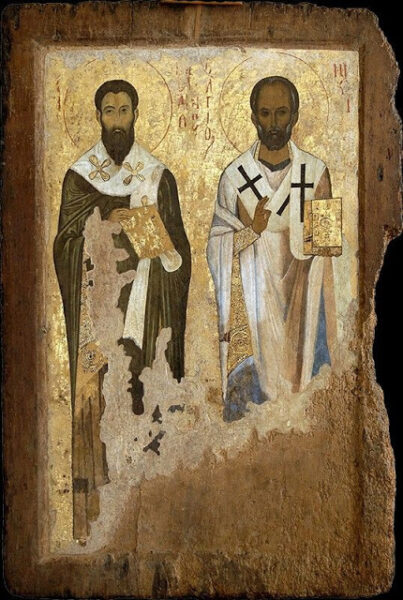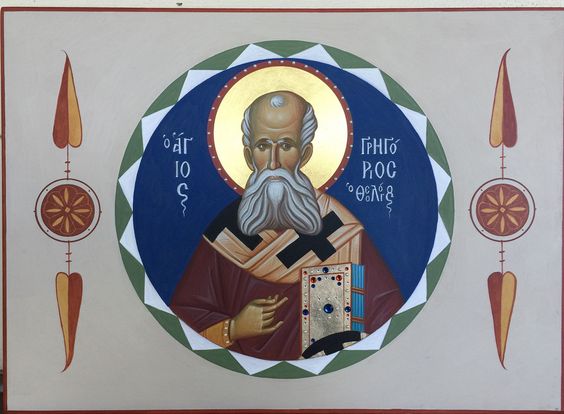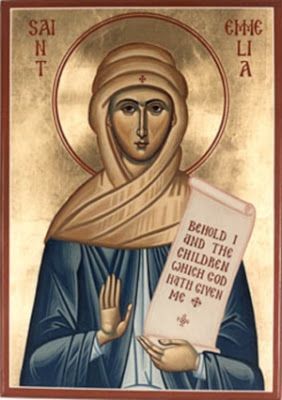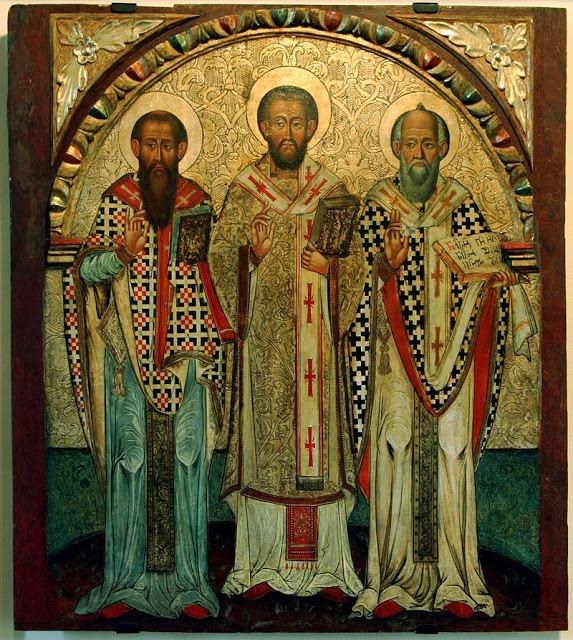Saint Vasileios – Basil the Great – Bishop of Caesarea

Basil the Great – Bishop of Caesarea – Saint Vasileios
The Feast Day of Agios Vasileios or Basil the Great, Bishop of Caesarea is celebrated on the first of January; New Year’s Day.
Traditionally Greek children don’t receive presents from Santa Claus, Saint Nicholas, on Christmas Eve but are visited by Agios Vasileios ( Saint Basil the Great or Basil of Caesarea) the Greek Father Christmas, on New Year’s Eve.
Saint Vasileios became the Greek Father Christmas as a result of his kind and humble character and his generosity towards the poor to whom he distributed all his worldly goods.

Saint Basil (Vasileios) & Saint Nicholas
The tradition is basically the same; ‘Agios Vasilis’ arrives with his bulging sack of toys and gifts, children are told “If you don’t behave, ‘Agios Vasilis’ won’t visit you” and letters are sent to him.
However, rather than rounding up the reindeer and hopping on his sleigh in Lapland, Agios Vasilis sets off from Caesarea (Kayseri, modern day Turkey) for his busy New Year’s Eve in Greece.
One Greek New Year tradition is that of families setting an extra place at the table for Saint Vasileios when celebrating on New Year’s Eve, where there will be the special New Year’s cake, the vasilopita, waiting to be cut and children will eagerly be awaiting the Greek Father Christmas, or should that be Father New Year?
The Life of Saint Vasileios
Vasileios (330-379) a much-loved Saint of the Greek Orthodox Church, Patron Saint of Russia, Cappadocia, monks, education, hospital administrators, exorcism and liturgists, was born into a wealthy, religious, Greek family, in Caesarea, Cappadocia, Asia Minor (Modern day Turkey), one of ten children (some sources state six), five of whom became Saints.

Kayseri, modern day Turkey. (Caesarea)
Vasileios’ mother; Saint Emilia was the daughter of a martyr, his grandmother was Saint Macrina the Elder, his sister was Macrina the Younger, his brother was Saint Peter of Sebaste, another brother was Saint Gregory of Nyssa and his youngest sister is said to be Saint Theosebia so it was in the blood, no surprise that Vasileios himself became a saint!

The Holy Family of St. Basil: (left to right, first row) St. Peter of Sebaste, St. Basil the Great, St. Basil, St. Gregory, (second row) St. Theosevia, St. Naukratios, St. Emmelia, (top) St. Macrina
Vasileios studied in Mazaca, Cappadocia, where he met and went on to be life-long friends with Gregory of Nazianus; Archbishop of Constantinople.
He continued his studies in Constantinople, spent six years in Athens, where he met Julian the Apostate, (Roman Emperor 361-363) and travelled around Egypt and Syria before returning to Caesarea where he practiced law and taught rhetoric.

St. Gregory the Theologian of Nazianzus. Archbishop of Constantinople
Vasileios becomes a monk
Vasileios’ life changed the day he met Eustathius of Sebaste, an alluring, charismatic monk.
He closed his law books, gave up teaching, travelled through Palestine, Egypt and Syria, where he studied asceticism and monasticism, gave all his inheritance to the poor and became a monk, saying:
“I had wasted much time on follies and spent nearly all of my youth in vain labours, and devotion to the teachings of a wisdom that God had made foolish. Suddenly, I awoke as out of a deep sleep. I beheld the wonderful light of the Gospel truth, and I recognized the nothingness of the wisdom of the princes of this world.”
Saint Basil – Bishop of Caesarea.
It didn’t take long for Vasileios to discover that a life of solitude was not for him and by 358, with a group of followers, including his mother, Emilia, brother, Peter, and sister Macrina, Vasileios established a monastic commune on the family estate at Annesi, where life was devoted to prayer and charitable works.

Macrina the Elder. Grandmother to Vasileios

Saint Emilia. Mother to Vasileios

Macrina the Younger. Sister to Vasileios
In 362 Vasileios was made a deacon by Bishop Meletius of Antioch and in 365 he was called to Caesarea as presbyter of the church there and in 370, after the death of Eusebius, became Bishop of Caesarea.

Fresco of Basil the Great (Vasileios) in the cathedral of Ohrid. The saint is shown consecrating the Gifts during the Divine Liturgy which bears his name.
The good works and institutes of Saint Vasileios
During his time in Caesarea Vasileios defended the orthodox faith against the heresy of the Arians.
He wrote many works on theology and canon law.
His writings about monasticism have influenced many religious orders in Eastern Christianity, some of which bear his name.
The Basilian Fathers, also known as The Congregation of St. Basil, an international order of priests and students studying for the priesthood, is named after him.

Basil the Great. Bishop of Caesarea. Saint Vasileios
Vasileios created the “Basiliad”; a philanthropic foundation, a large complex, outside Caesarea, consisting of hospitals, an orphanage and a poor house.
Here free of charge, the sick, poor and aged could receive food, shelter and medical care, he organized soup kitchens, distributed food and tried to reform thieves and prostitutes.

Basiliad. Image thegreathospital.co.uk
Feast Day
The Feast Day of Agios Vasileios or Basil the Great, Bishop of Caesarea, the first of January, New Year’s Day.
He is also one of the Three Holy Hierarchs (influential bishops of the early church), along with Gregory of Nazianzus and John Chrystom and so is also celebrated on January 30, Feast of The Three Holy Hierarchs.

Three Holy Hierarchs. Basil the Great (left), John Chrysostom (center) and Gregory the Theologian (right)
Saint Vasileios is also known as one of the Three Cappadocians or The Cappadocian Fathers which include his younger brother, Gregory of Nyssa and his close friend Gregory of Nazianzus.
The holy skull of Saint Vasileios (Saint Basil) is kept at the Great Lavra Monastery, Mount Athos, Greece.

The Holy Skull of Saint Basil (Vasileios). Great Lavra Monastery. Mount Athos Greece
Related link:
Saints and Celebrations of the Greek Orthodox Church



